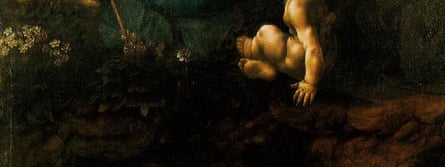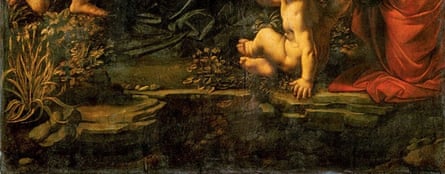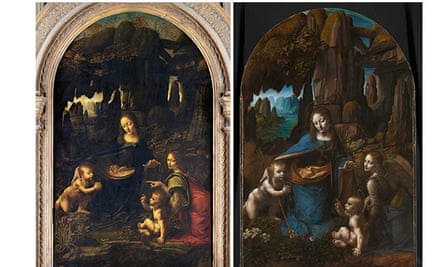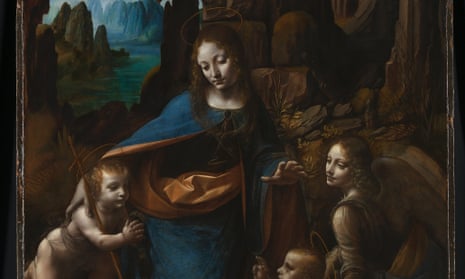Leonardo da Vinci always impressed on his students the importance of depicting nature accurately. He wrote: “Painter, you should know that you cannot be good if you are not a master universal enough to imitate with your art every kind of natural form.” Indeed, his own paintings and drawings of the natural world are as scientifically accurate as they are beautiful.
Five centuries on, scientists and art historians are trying to work out to what extent Leonardo had a hand in both versions of Virgin of the Rocks – the one in the Louvre, in Paris, and the replica in the National Gallery in London.
Doubts have long been cast over whether the Renaissance master made the London painting. Until 2010, the National Gallery believed it was mainly the work of assistants but, after restoring it, declared it possible that Leonardo painted all of the picture himself. Now, analysis of the vegetation and geology in the landscape around the central figures is reviving the debate.

“The botany in the Louvre version is perfect, showing plants that would have thrived in a moist, dark grotto,” says Ann Pizzorusso, a geologist and Renaissance art historian. “But the plants in the London version are inaccurate. Some don’t exist in nature, and others portray flowers with the wrong number of petals.”
She concludes: “It seems unlikely the same person could have portrayed rock formations so accurately in the Louvre work and so incongruously in the National Gallery one – especially considering Leonardo’s faithfulness to nature. There is absolutely nothing in his body of work that is not true to nature.
Her conclusions are supported by John Grimshaw, a leading horticulturalist, who is struck by the realism of the Louvre painting, unlike the National Gallery version. In the French painting, he can easily identify iris, polemonium and aquilegia. He says: “There’s a very recognisable iris, a Jacob’s Ladder, a nice little palm tree, all sorts of well-observed bits of vegetation there – and proper plants.”

The London painting features invented plants that bear no resemblance to reality. “It’s very striking, because they go against everything that Leonardo’s always done in terms of his botanical art. They’re not real flowers. They’re odd concoctions, like a half-imagined aquilegia. And looking at the daffodil, for example, the flowers are OK, but the plant is not right.”
Pizzorusso draws on Grimshaw’s analysis in her latest research, published this month in her book, Tweeting da Vinci, which focuses on Leonardo’s geology, hydrology and water engineering.
The Louvre version is a geological tour-de-force, she says, a complex landscape in which each rock formation can be identified: “To the right of the virgin’s head is weathered sandstone, and above it is a contact surface with a strata of diabase and above that is spheroidal sandstone.” In the London version, she says, the rocks are unrealistic. The artist – whoever that was – lacked both technique and appreciation for geology. “The rocks are all angular and blocky, with no distinctive texture.”
She notes that the Louvre version positions plants where they would grow naturally: “At the top of the grotto, the sandstone would have decomposed sufficiently to allow roots to take hold.” No plants grow out of the diabase, because it’s too hard and resistant to erosion to allow growth.

The rocks in London, she suggests, “miss the point geologically”. Above the virgin’s head, there is no change in the rock texture to indicate a diabase sill. The rock remains the same, in comparison to the subtle changes in the Louvre work. She adds: “In the foreground, the rocks are simply not identifiable.” She concludes that Leonardo’s hand is not visible in the natural world of the London version.
Grimshaw, who serves on various committees of the Royal Horticultural Society and is director of the Yorkshire Arboretum at Castle Howard, calls the differences between the versions “surprising – if not shocking”.
Michael Daley, director of watchdog ArtWatch UK, describes this latest evidence as “the nail in the coffin of the attribution to Leonardo”, adding: “Leonardo’s raison d’être was understanding and describing nature. It’s inconceivable that … he could have bowdlerised his … understanding on a single painting.”
Renaissance scholar Charles Hope is among those who have previously questioned the attribution of the London version. Responding to this botanical analysis, he says: “If [the botany] is crazy in one but not in the other, we can draw some conclusions.” Nor does he believe that Leonardo would have painted two versions. A copyist, he believes, would be less concerned about accuracy.
The National Gallery declined to comment on the new study, and pointed to its published research, which acknowledges previous doubts that Leonardo was solely responsible for the London version. It also states that the Louvre picture relies on “entirely naturalistic tactics to give the picture its spiritual flavour” while the London version is “rendered notably less naturalistically … an ideal world made before the physical creation of our own imperfect cosmos”.

Comments (…)
Sign in or create your Guardian account to join the discussion